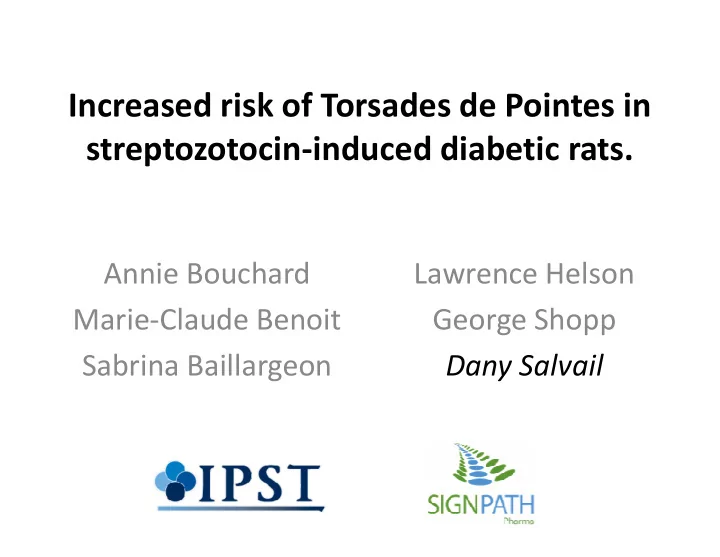

Increased risk of Torsades de Pointes in streptozotocin-induced diabetic rats. Annie Bouchard Lawrence Helson Marie-Claude Benoit George Shopp Sabrina Baillargeon Dany Salvail
Long QT in diabetic patients Bradycardia CV autonomic Torsades Sudden Type-1 Diabetes neuropathy de Pointes cardiac death Prolonged QTc Low KChIP2 (I To ) and High Persistent INa Low Insulin hERG (I Kr ) expression (INaP) density Why are diabetic patients at greater risk of sudden cardiac death? • QTc prolongation is present in 9-16% of type-1 diabetic patients. • Diabetic autonomic neuropathy is frequent; • Humans with autonomic system disorders/impairments are more susceptible to drug-induced QTc prolongation
The project • Rationale With a reduced repolarisation reserve, human diabetic patients may not be adequately represented in our current cardiac safety models. • Purpose 1. To characterize the extent, timing, and potential causes of QTc prolongation in a type-1 diabetic rat model 2. To confirm that this type-1 diabetic model exhibited enhanced sensitivity to drug-induced QTc prolongation 3. To test a novel compound with a potential novel mechanism of drug-induced LQTc mitigation
Induction of type-1 diabetes • Adult male Sprague-Dawley rats • One 45 mg/kg iv injection of streptozotocin on Day 1 • Day 3: Implantation of subcutaneous osmotic pumps filled with slow insulin formulated in proprietary stabilization buffer: 2 units per day delivered for 30 days • The animals were fed normal rat chow ad libitum • Daily glycaemia tests, clinical signs assessment; weekly insulin tests and ECG recordings under isoflurane anesthesia prior and after induction • Drug-induced QTc challenges on Day 30: – 3 mg/kg crizotinib (lung carcinoma) – 4 mg/kg nilotinib (myelogenous leukemia) – i.v. injections followed by 30+ minutes of recording
Progression of the disease: Insulin and glycaemia Progression of glucose and insulin levels after induction 60.0 Blood glucose (mmol/L) Blood insulin (µU/mL) 50.0 40.0 * * * * * * * 30.0 * * 20.0 * * * * * * * * 10.0 * * 0.0 Baseline Pump + 24h Week 1 Week 2 Week 3 Week 4 Glucose: OneTouch Verio IQ Insulin: Abcam ELISA
Progression of the disease: QT prolongation Progression of QTc and insulin levels after induction 195 60 * * 190 50 * 185 180 40 Insulin (µU/L) * QTc (ms) 175 30 170 165 20 * 160 * * * 10 155 150 0 Baseline Week 1 Week 2 Week 3 Week 4 As expected, the kinetics of hypoinsulinemia appear faster than those of QTc prolongation. Yet QTc is statistically increased after only 1 week, levels off after 3 weeks post-induction
Decreased repolarisation reserve QTc prolongation in normal and diabetic animals 240 ** 220 ** 200 * QTc (ms) * * 180 160 140 120 100 Pre-challenge Nilotinib, 4 mg/kg Crizotinib, 3mg/kg Nilotinib: Tyrosine kinase inhibitor for the treatment of chronic myelogenous leukemia Crizotinib: anaplastic lymphoma kinase inhibitor, for the treatment of non-small cell lung cancer. For both these compounds, QTc prolongation is one of the dose-limiting toxicities.
Mitigation of QT prolongation: EU-8120 • EU-8120 : A proprietary eutectic Nilotinib-induced QTc prolongation in type- blend of phospholipids and fatty 1 diabetic rats 240 acids * • By itself, does not revert the 220 diabetic-induced LQTc QTc (ms) 200 • Shown to have IKr/hERG current 180 -salvaging properties 160 • Currently in clinical 140 development: it mitigates dose- 120 limiting cardiovascular toxicity and opens the therapeutic 100 Control Nilotinib EU-8120 EU-8120 window for black-labelled drugs + Nilotinib
Prevention of hERG current inhibition hERG current inhibition by Nilotinib and Crizotinib Normalized Current 1.00 Density * 0.50 * 0.00 Baseline Nilotinib Nilotinib EU-8120 Crizotinib Crizotinib + EU-8120 +EU-8120 • Manual patch-clamp, physiological temperature, using HEK293 hERG-expressing cells. • Nilotinib and Crizotinib both inhibit hERG, and received a QTc warning label. • EU-8120 removes the hERG inhibition completely when administered at a ratio of 9:1
Conclusion Wrap-up • Streptozotocin-induced type-1 rats exhibit QTc prolongation (Shimoni 1994, Ren 1997, etc.) • Insulin depletion plays a role in the prolongation of QTc in the type-1 diabetic rats (Harris, 1996) • The extent of QTc prolongation can be dialed in with insulin pumps • Type-1 diabetic rats are more sensitive to QT-prolonging drugs (reduced repolarisation reserve) • Maintaining a functional hERG signal contributes to preventing QTc prolongation in type-1 diabetic rats (EU-8120) • Not shown: In contrast, maintaining hERG function is NOT sufficient to prevent drug-induced LQT in type-2 rats: EU-8120 prevents hERG inhibition by nilotinib, but not nilotinib-induced LQT. The core difference between the two types of diabetic rats is the circulating insulin level.
Special thanks • Lawrence Helson (SignPath Pharma) • George Shopp (Shopp Consulting) • Walt Shaw (Avanti Polar Lipids) • Marie-Claude Benoît IPST • Sabrina Baillargeon IPST • Rosie Kryczka IPST • Annie Bouchard IPST More information on Poster 039
Recommend
More recommend